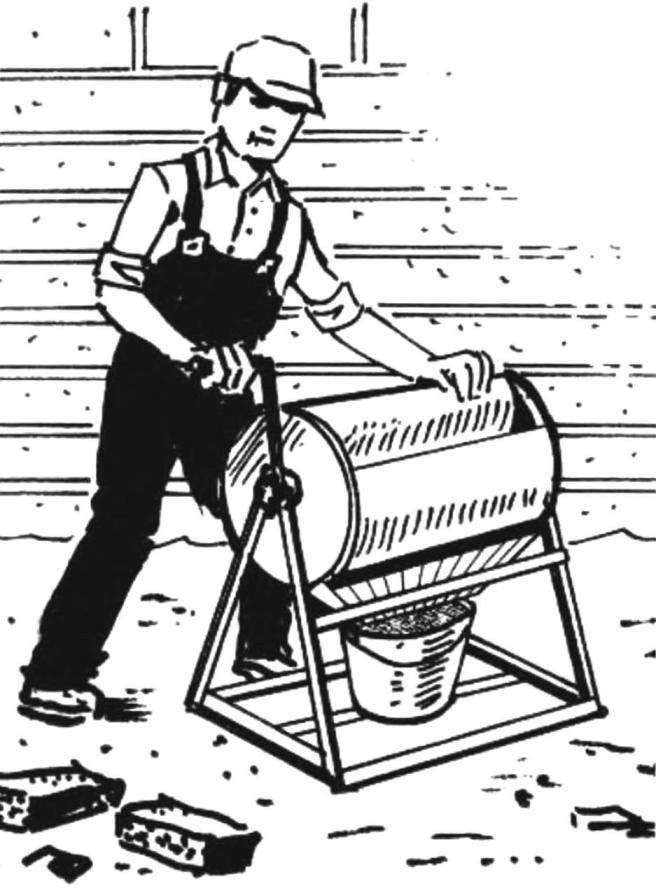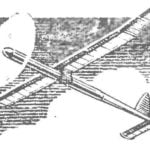 Any individual developer wants to ease heavy physical labour during various construction works, seeking for opportunities to mechanize. But as is often the case, electricity on the plot at this time yet.
Any individual developer wants to ease heavy physical labour during various construction works, seeking for opportunities to mechanize. But as is often the case, electricity on the plot at this time yet.
One of the most difficult but necessary types of work — preparation of mortar and concrete mixes. In this case, considerable importance as productivity and quality of mixing.
It is clear that the shovel and trough these problems are not addressed, so developers in such a situation, seek to acquire or manufacture the concrete mixer hand operated. However, it is not easy to determine the design options and choose the best. So it was with me. After reviewing the proposed mechanisms in the construction markets and having studied special literature, eventually developed its own version. And the construction is almost available at hand materials and subjected to thorough tests on building your own garden.
Now an advanced draft of this mixers offer readers of the magazine “modelist-Konstruktor”.
In appearance my mixer practically does not differ from their peers. The frame is made in the form of a regular prism laid on its side, the mixer drum. Unusual my mixer just the fact that her shell is not welded, as usual, in a closed cylinder, and then in her last quarter folded inside in a spiral and extended to the intersection with a diametral plane (even a little more) passing through the beginning of this quarter.
This design of the mixer allows to do without the blades, ribs, and other internal devices for mixing the components: it is made partially during the rotation of the drum and in full at the time of nispadaya components with the inner edge of the shell on the outer surface (like water in a waterfall).
Another advantage of my mixer in front of others — she has no special loading and unloading hatch, which is necessary each time to open before you die and fall of the mixture from the bowl and tightly “sealed” after it downloads components. This greatly reduces the cycle time of mixing, i.e., improves the performance of the equipment. But that’s not all. In conventional concrete mixers is very difficult to determine the degree of readiness of the mixture. I’m watching the stirring during the process, and if necessary, add water, almost non-stop, without reducing the performance of the hardware, but also providing a high quality mix.


Spiral rastvoromeshalke:
1 is a longitudinal rail of the frame (area 32x32x4, 2); 2 — area for installation shipping container (corrugated steel sheet s3); 3 — crossbar (28x28x3 area, L712); the tray 4 (sheet steel, s1); 5 — axis arm (St3, circle 20); 6 the lever arm (St3, strip 30×4); 7 — flange of the mixing drum (St3, sheet s1,5. 2); 8 — half sliding bearing (wood, solid hardwoods, bar 32×20, L70, 4x); 9 panel (St3, the sheet s10, 2); 10 — jumper (St3. sheet s3); 11— front frame (area 32x32x4, L835, 4-piece — mirrored pairs); 12 — the axis of the drum (St3, round 26); 13 — shell of the drum (St3, sheet s1,5); 14 — drum shaft (St3, round 26); 15 — arm (St3, pipe 25×2); 16 — coupling (St3, strip 30х1,5, L160); 17 — transverse connection of the frame (area 32x32x4, L787, 2); 18 — carrying capacity (bucket)
For shell requires a fairly large area of the steel sheet. But if necessary, this detail can be welded (or riveted) from two or more smaller sheets. Similarly, you can assemble several sheets of metal and the tray.
Frame mixers (rail and rack) welded mostly steel angle corner 32×32 mm.
It should be noted that the installation drawings are developed for its production in the equipped workshop, where there is a possibility of cutting, bending and welding metal, but can also perform turning and boring operations. However, this should not stop homebrew is because a prototype of this mixer I have made literally on the “knee” of the material that was at hand.
So, the shell is made of roofing iron, the flanges of 10 mm plywood, the frame is of timber. All the parts together was bolted M5 — M6. But with the help of such a primitive design, I managed to prepare all the necessary volume of concrete for the Foundation of a country house, and receive the mortar for plastering of its walls.
For mixing the components to load: sand, gravel (crushed stone), cement, can occur in any order, but the best cement load between inert materials. The mixing process starts after pouring in the water mixer — at the same time facilitates the sliding of the mixture on the walls of the drum. Practice has shown that to obtain high-quality solution is sufficient for 10 — 15 revolutions of the drum, which takes 20 — 30 seconds. Thus, the cycle of mixing is mainly determined by the loading time in the mixer of concrete components. To save time (and effort) on the delivery of ready mix concrete mixer can be installed directly above the formwork.
In a mixer for a few minutes can be cooked clay dough. Only the dry clay must be pre-crushed to crumbs size 3 — 5 mm.
Unloading of the mixture is performed by slow rotation of the drum in a clockwise direction.
After work, the mixer should be washed. For this drum it is necessary to pour water (about a bucket) and actively rotating. To clean the inner part of the dried residues of mortar or concrete, except water, should be poured into the drum a quantity of gravel or, even better, crushed stone and also actively rotate.
G. KASATKIN



